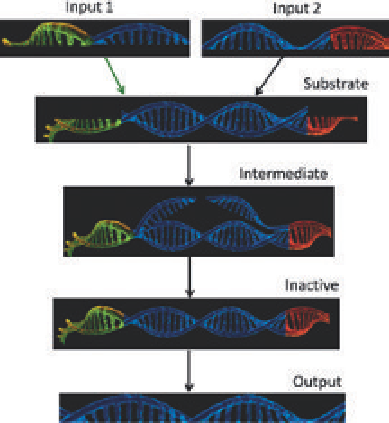Information Technology Reference
In-Depth Information
Fig. 15.24. A DNA logic gate. This gate
takes two DNA strands as input and only
produces an output if both input strands
are present.
sequence of A, T, C, and G. All the possible paths were represented by comple-
mentary DNA sequences consisting of the last half of a strand corresponding
to a departure city and the first half of another strand representing a possible
arrival city. Adleman mixed the DNA strands together and all the possible paths
were generated, created by the complementary A-T and C-G bonding between
the strands. He then had to perform a manual analysis to separate out mol-
ecules representing paths that did not start or end with the right city or paths
that did not go through all the different cities. This DNA-based computation
produced all possible paths very quickly due to the large number of molecules
involved, but the manual analysis to separate out the strands for valid paths
took several days. So although Adleman's work was an interesting experimen-
tal approach to computing with DNA, it was not a practical method for solving
large-scale problems in a reasonable time.
An alternative direction for DNA computing has been to focus on creating
more general-purpose computational circuits using both single-stranded and
double-stranded DNA. The technique is called
strand displacement
, and the inter-
actions are specified by the choice of complementary DNA sequences. A strand
displacement reaction is initiated when a short portion of an incoming single
strand binds to a complementary exposed portion of a double-stranded com-
plex. If the remaining sequence of the incoming strand matches the sequence
of a neighboring strand in the complex, the incoming strand will displace the
existing strand through strand displacement. In this way, researchers have
been able to create logic gates from DNA (see
Fig. 15.24
). Several research
groups are experimenting to scale up such strand displacement gates to per-
form complex computations. The ultimate goal of this research is to make pro-
gramming DNA circuits as straightforward as programming computers.
Key concepts
Nanotechnology
Memristor

Search WWH ::

Custom Search